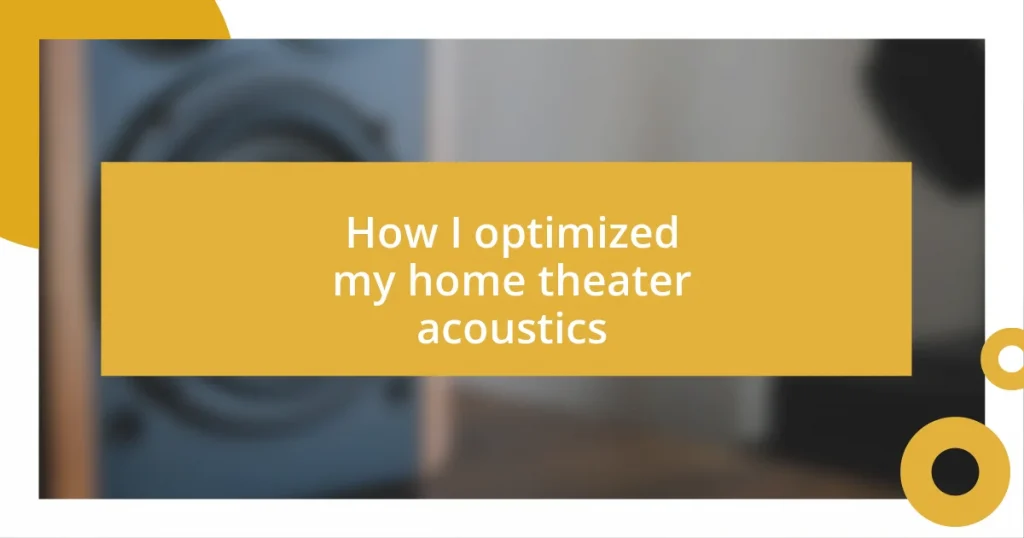Key takeaways:
- Understanding acoustics involves recognizing the impact of room shape, surface types, and sound reflection/absorption on audio quality.
- Proper speaker placement and selection, alongside the use of acoustic treatments, can dramatically enhance the sound experience in a home theater.
- Measuring sound quality improvements through listening tests and sound meter apps helps identify and refine acoustic adjustments for an immersive experience.

Understanding home theater acoustics
Home theater acoustics is all about how sound behaves in a given space. I remember the first time I cranked up my favorite movie in my newly set up theater; the sound felt flat, and the dialogue was muddled. It struck me then how crucial it is to understand the interaction between sound waves and surfaces in your room.
When I began experimenting with my setup, I found that hard surfaces like tile or glass can reflect sound, creating echoes and an overall chaotic audio experience. Have you ever been to a restaurant where the noise just bounces around? It’s not pleasant, right? A similar environment in your home theater can seriously detract from the immersive experience you’re trying to create.
In my quest for perfect sound, I learned that soft furnishings, like carpets and curtains, are essential for absorbing sound waves. I still recall the moment I added some plush rugs to the floor; the warmth and clarity of the audio transformed dramatically. Isn’t it fascinating how simple adjustments can lead to such profound improvements in how we perceive sound?

Key acoustic principles for optimization
To really dive into optimizing your home theater acoustics, it’s essential to grasp some key acoustic principles. I found that the positioning of speakers plays a pivotal role. For instance, placing my surround speakers at the right height and angle helped create a much more immersive soundstage. It was like flipping a switch; the audio quality shifted from average to astonishing in mere moments.
Here are some important principles to consider:
- Sound Reflection: Hard surfaces reflect sound, which can lead to unwanted echoes.
- Absorption: Soft furnishings like curtains and carpets absorb sound waves, reducing muddiness.
- Diffusion: Introducing different materials can spread sound evenly in the room, improving clarity.
- Speaker Placement: Properly positioning speakers ensures sound reaches the listener effectively.
- Room Shape: The geometry of the room affects how sound travels; aim for balanced dimensions.
Through my experience, learning about these principles provided a solid foundation. Each discovery felt like unearthing a hidden gem, enhancing my home theater experience overall.

Assessing your room’s acoustics
When I first set up my home theater, I began by just standing in the room and listening. I was surprised by how uneven the sound was—some areas were booming, while others felt dull. This inspired me to really assess the acoustics by observing how sound traveled through the space. It reminded me of adjusting a musical instrument; sometimes, it just needs the right touch to resonate perfectly.
I also took a moment to consider the size and shape of my room. The dimensions played a critical role in the audio experience. Interestingly, I noticed that my long, narrow setup seemed to amplify certain frequencies, leading to bass overwhelming the overall sound. It was as if each corner was a contributor to the orchestra, either playing beautifully or clashing in dissonance. Have you thought about how your room shape affects your sound experience?
To get a clearer picture, I found that employing simple sound tests helped immensely. I played various genres of music, noticing how different styles affected the acoustics. A classical piece brought out harsh reflections, while a smooth jazz tune felt soothing and rounded. Using this method, I could identify specific problem areas, setting the stage for targeted improvements that transformed my sound experience from mediocre to mesmerizing.
| Aspect | Observation |
|---|---|
| Room Size | Long and narrow rooms may amplify bass frequencies |
| Surface Types | Hard surfaces can create echoes, while soft furnishings absorb sound |
| Sound Testing | Listening to various music genres can highlight acoustic issues |

Acoustic treatments and solutions
Addressing acoustic treatment and solutions is where the magic really happens in your home theater. When I started adding sound-absorbing panels, I was amazed at the difference. I remember standing in the room after installing those first few panels, and the sharpness of the sound dissolved into a smooth, even wave. It was as if the room took a deep breath and exhaled pure audio bliss. Have you ever experienced a moment where the sound just felt right?
Another effective solution I discovered was using bass traps in the corners of my room. Initially, I had no idea these could make such a difference, but after installing them, the low-end frequencies tightened up significantly. The deep rumble of explosions in movies no longer felt overwhelming; instead, they became rich and defined, enhancing the overall cinematic experience. I often find myself wondering how such simple additions can create such a profound change—it’s a wonderful reminder of the power of acoustics.
Lastly, consider softening your room with rugs, curtains, and upholstered furniture. I used to think the aesthetics didn’t matter much, but I was wrong. A plush rug underfoot not only looked great but also helped absorb sound, cutting down on those pesky echoes that used to bounce around the room. It’s fascinating how the right decor choices can marry beauty and function. Have you thought about what your space might need to elevate its auditory performance? Mixing aesthetics with sound treatment can truly elevate the experience to new heights.

Choosing the right speakers
Choosing the right speakers is one of the most critical steps in optimizing my home theater acoustics. Initially, I went with a popular brand based on recommendations and reviews. However, after some experimentation, I realized that the speaker type and placement profoundly influenced the sound landscape. Have you ever noticed how a great movie just doesn’t hit the same without the right audio backing it up?
I learned early on that matching my speakers to the room size was key. For instance, I had compact bookshelf speakers in a large room, and the audio felt flat and uninspired. Swapping them for floor-standing speakers not only enhanced the clarity but even made the dialogue pop. It was a revelation! I still remember the rush of excitement when I first turned on a dramatic scene; the sound enveloped me like a warm embrace, transforming the viewing experience entirely.
Another factor I found essential was the configuration of my speaker setup. At first, I thought a simple surround sound system would suffice. However, I soon discovered that speaker positioning played a huge role in creating a soundstage that felt immersive. Experimenting with angles and distances made a world of difference. It made me ponder how often we overlook the foundational setup in our quest for a cinematic experience. Have you considered re-evaluating your own arrangement? The right configuration can truly be a game-changer in feeling right there within the action.

Measuring improvements in sound quality
When it came to measuring improvements in sound quality, I relied heavily on my ears, but I also embraced the use of a sound meter app. It was eye-opening to see the difference in decibel levels before and after I applied acoustic treatments. I distinctly remember the joy of watching the needle settle into a balanced range, confirming what my ears had already experienced—less distortion and a more even frequency response.
I also took the time to tweak my speaker placement based on the measurements I gathered. Each adjustment came with its own set of discoveries; I felt as if I were gradually uncovering the hidden layers of my sound system. For example, moving a speaker just a few inches forward changed how dialogue resonated in the room, creating a clearer and more immersive experience. It’s incredible how small tweaks can lead to such profound shifts—have you ever felt like you were just one adjustment away from perfection?
Listening tests were crucial too. I curated a playlist of scenes from my favorite movies and began to notice when sound effects or music took on a new life. The bass that once muddied the mix became tighter and more powerful, transforming my emotional connection to those moments. I remember being completely lost in the score of a film, feeling it resonate in my chest rather than just in the air. Measuring sound quality isn’t just about graphs; it’s about rediscovering the emotional impact of audio all over again. Are you ready to experience that for yourself?















